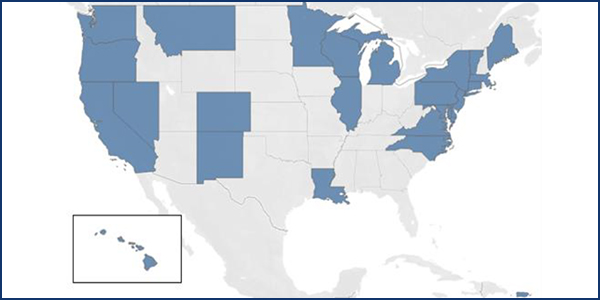States that have set goals to reduce greenhouse gas emissions have yet to implement sufficient policies to meet their pledges, the Environmental Defense Fund said in a study released Wednesday.
Twenty-five states and Puerto Rico, which have pledged to meet the U.S. commitment under the Paris Agreement on climate change, are on a trajectory to reduce emissions by about 18% below 2005 levels by 2025, well below the 26 to 28% reduction promised, EDF said.
Based on emissions data from Rhodium Group, the study included Puerto Rico and 24 states that created the U.S. Climate Alliance after President Trump announced his intention to withdraw from the 2015 international agreement. It also included Louisiana, whose governor separately announced the state would meet the 2025 Paris target and eliminate net emissions by 2050.
EDF said the gaps are even larger when compared with the reductions the U.N. Intergovernmental Panel on Climate Change (IPCC) says are needed to avoid the worst consequences of climate change. The study said the states and Puerto Rico are on track to reduce emissions by only 11% from 2010 levels by 2030, rather than the 45% IPCC says is needed.
“While many states have taken important steps on climate, they are not moving fast enough to turn commitments into the policies that will lock in the needed reductions in pollution,” said Pam Kiely, EDF’s senior director for regulatory strategy. “Making a climate commitment is only the starting point — not the finish line. Even under a new president with a meaningful climate agenda, state policies are essential for securing significant and immediate reductions in climate-warming pollution. … It’s also time for states that haven’t made a climate commitment to join the effort.”
EDF’s study recommended the establishment of declining, enforceable limits on GHG emissions, citing the model of the Regional Greenhouse Gas Initiative. It also said a well designed carbon price “can enable much greater ambition by securing the most cost-effective reductions, jumpstarting innovation and accelerating early action.”
“Regardless of the specific suite of policies deployed, it is imperative that states focus on the targets they have set, acknowledge their current emissions gaps and take action to achieve quantifiable reductions in pollution needed to limit warming over the coming decades,” EDF said.
The study cited New Mexico Gov. Michelle Lujan Grisham (D) as setting a good example, saying she is “engaging in a robust data analysis, transparently laying out the emissions gap and setting a course to enact comprehensive emission-reduction policies to ensure the gap is closed.”
The study says that although the IPCC has also called for net-zero carbon dioxide emissions by 2050, the amount emitted before that year is also crucial. “Carbon dioxide can remain in the atmosphere for thousands of years, so emissions entering the atmosphere over the next few years will continue to warm the planet for many decades to come,” EDF said. “The earlier we reduce emissions, the better the chance we have at achieving temperature stability at desirable levels.”





